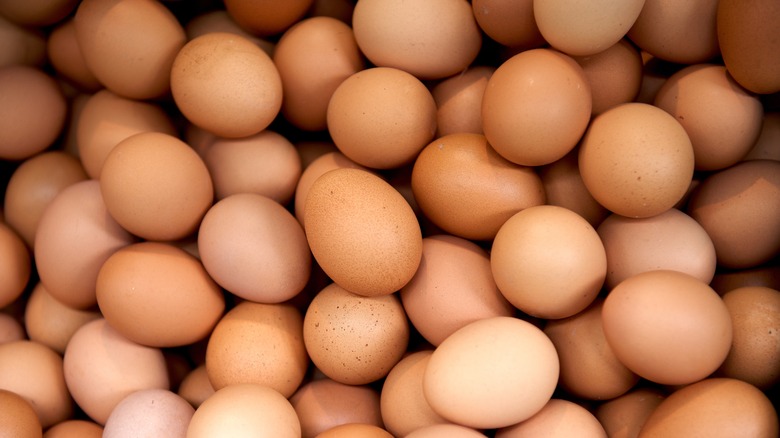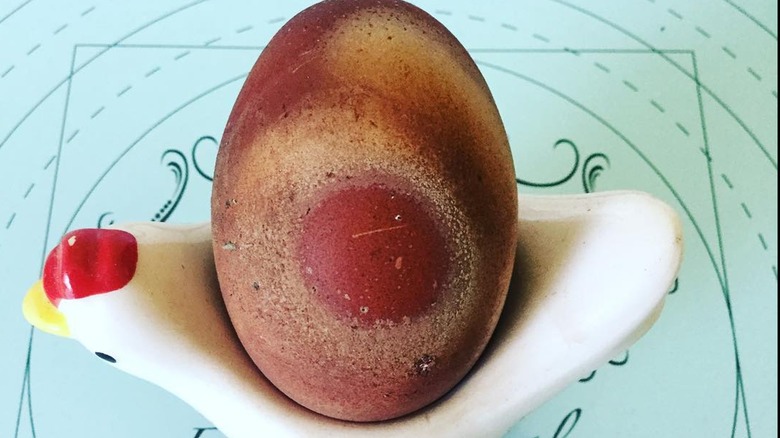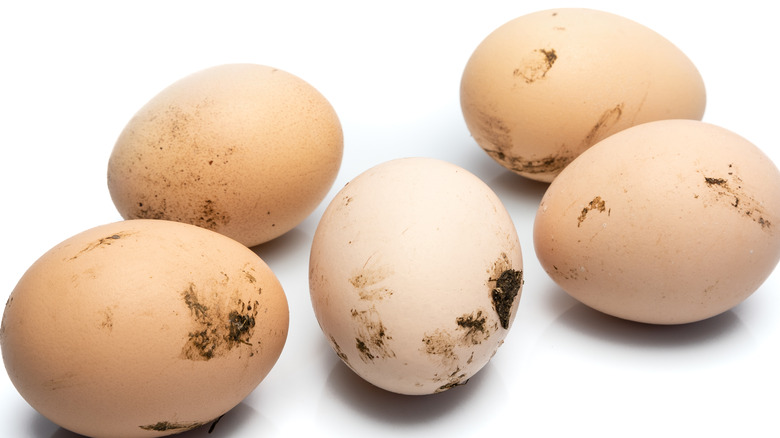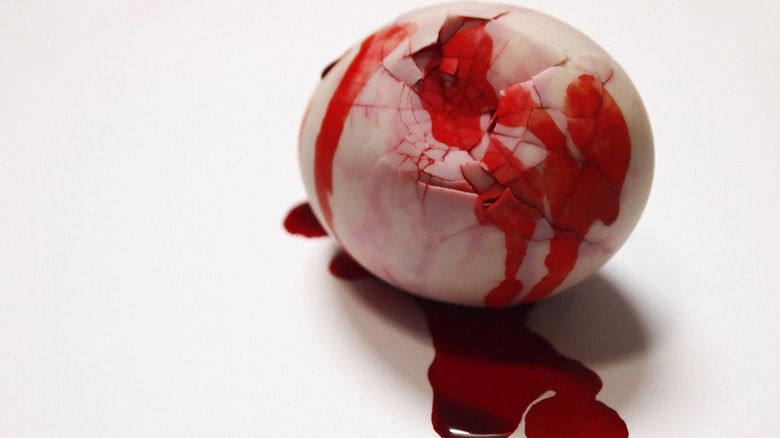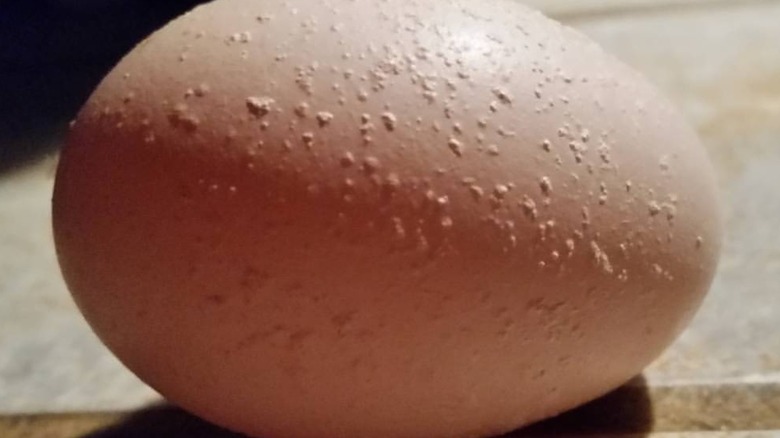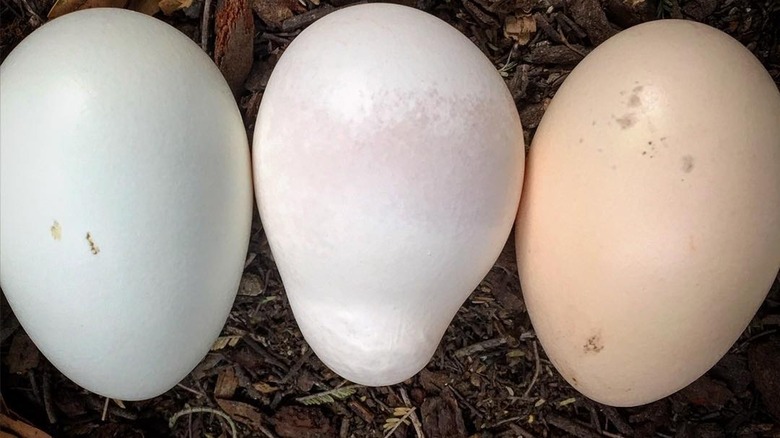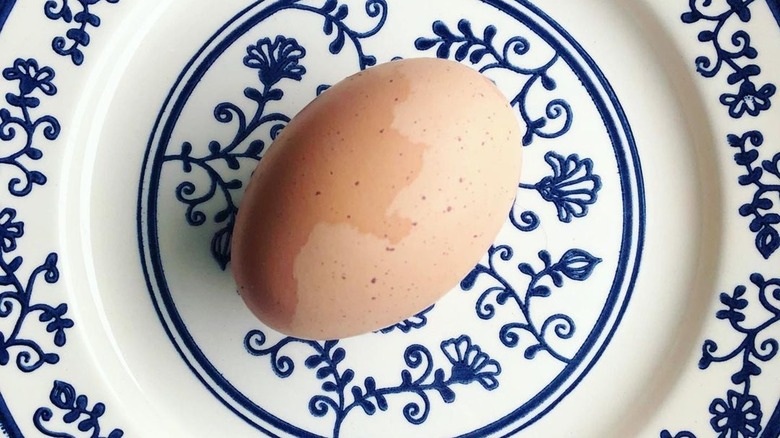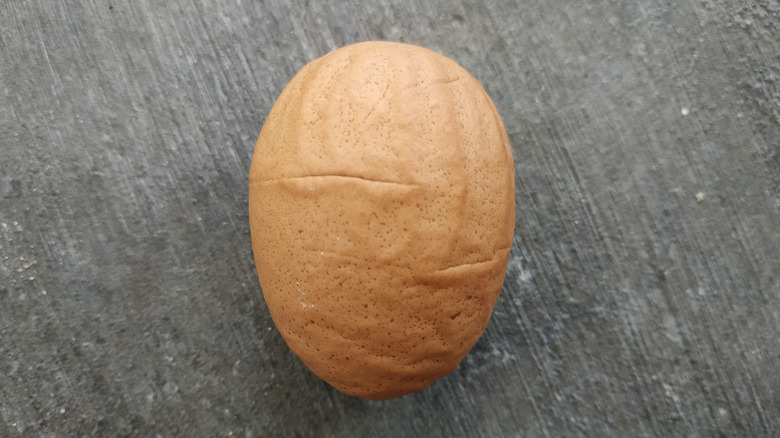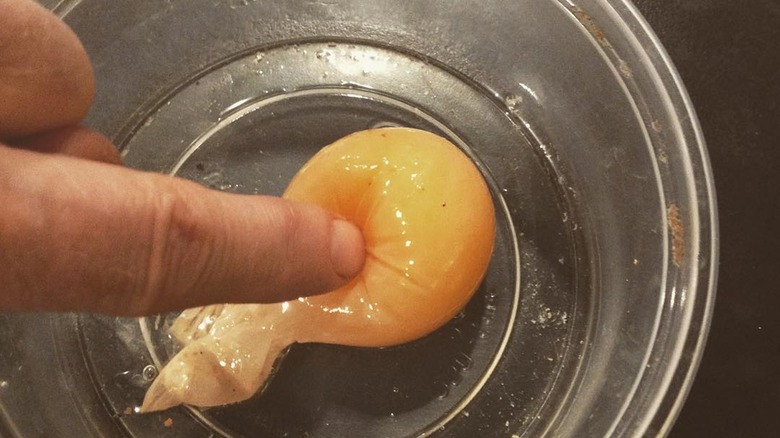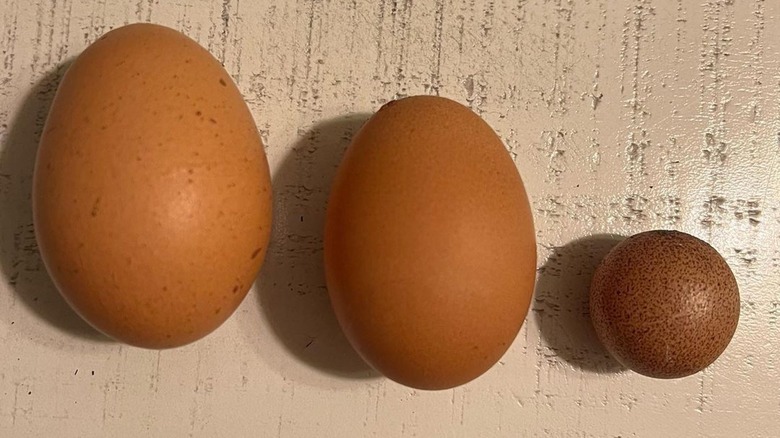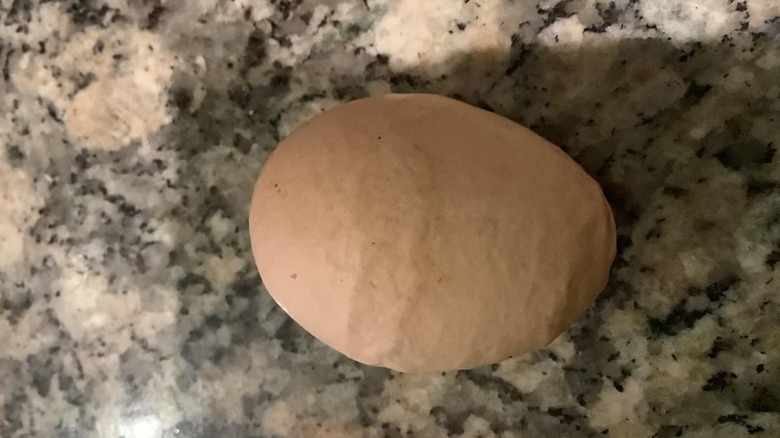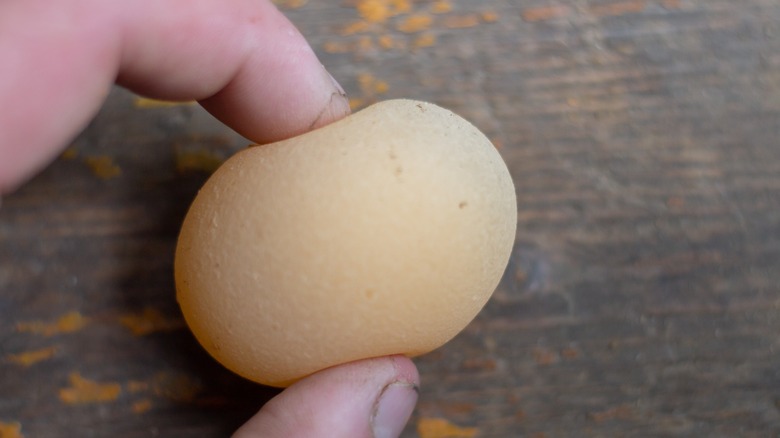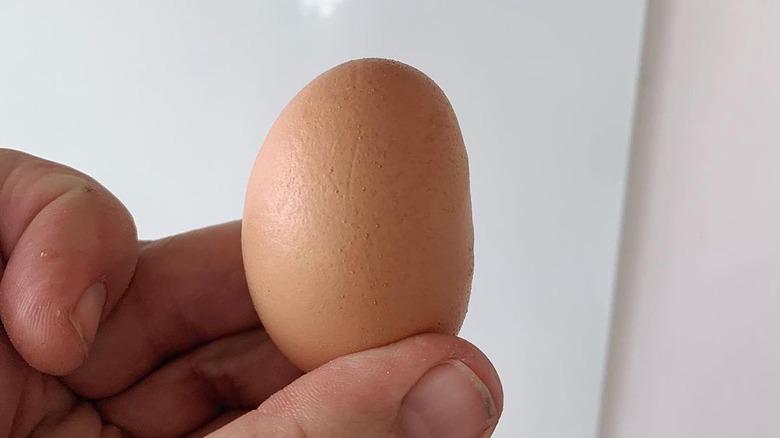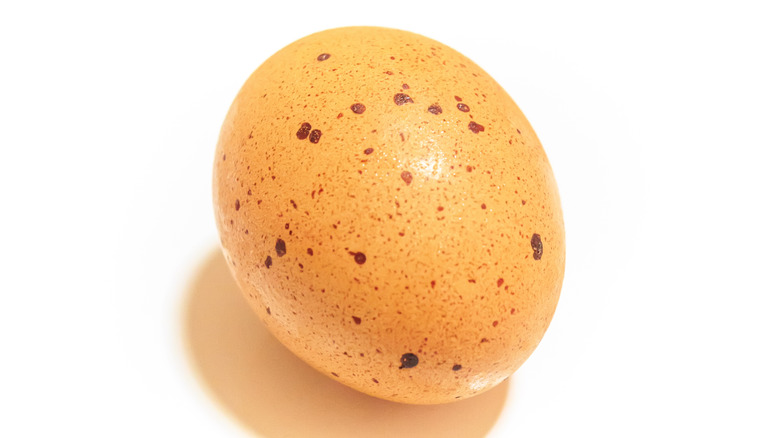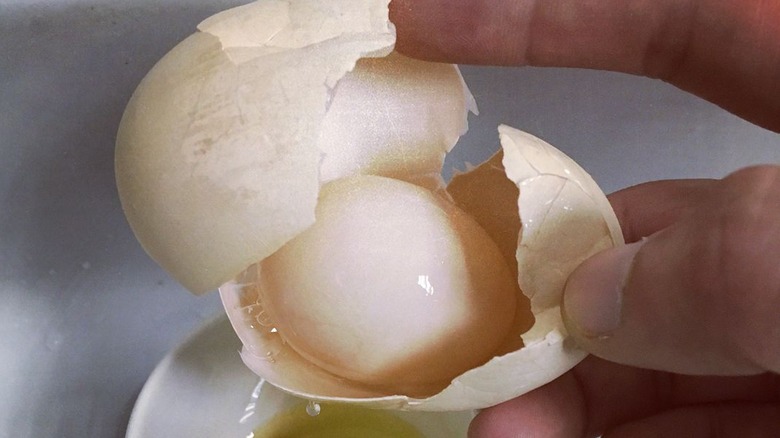The 15 Most Common Egg Defects And How They Happen
Raising backyard chickens may sound like an old-timey rural practice, but the ancient tradition is having a moment with urban and suburban residents. Whether they distrust factory eggs, crave fresher, more local food, or just like the idea of big fuzzy birds bopping around the backyard, a growing number of people are now raising their own chickens (and making their own loaves of sourdough, too).
But many found that the eggs in their coops didn't always look like those from a carton. Instead, some emerged with lumpy, discolored, or misshapen shells — or even no shells at all. If you raise chickens and have experienced this, it's not just you or your chickens: These are common problems, caused by factors ranging from the age of the hens to temperature, stress, or illness, which can all disrupt the normal production and growth of the egg and shell. And while most wonky-looking eggs are still safe to eat, unless they're occasional one-offs, they could indicate a sick hen or suboptimal living conditions. Here are some of the more common egg defects and why they happen.
White-banded eggs
A type of irregularity you may encounter is an egg with what looks like a water spot — a darkened roundish area surrounded by a white band. This odd marking is a sign that two eggs have passed through the hen's oviducts into the shell gland pouch (where the shell material is secreted around the rest of the egg) at the same time. These marks form when the two eggs and their partially formed shells come into contact with each other; the white ring is excess calcium that builds up on the first egg that enters the shell gland pouch.
This issue points to another abnormality: two eggs being laid at once. Normally, hens lay one egg at a time at roughly 24-hour intervals (they may skip days when they're molting or lay less frequently as they age). Egg production is also linked to hens' exposure to sunlight, so they tend to lay less in the winter when days are shorter. Conversely, artificial light in henhouses, sometimes used to stimulate laying during the winter, can trigger the production of multiple eggs, along with white-banded eggs. Stress and certain conditions, such as bronchitis, can also cause this defect.
Dirty eggs
When you buy eggs from the store, you expect them to be clean enough to crack straight into a pan for your morning fried eggs. When gathering eggs from your own hens, however, you probably expect to have to brush them off a bit before storing or cooking with them — depending on where they were laid, you could easily expect bits of straw, leaf litter, or soil to cling to them.
What you don't want, however, is the hens' fecal matter on the eggs. This can happen if you don't collect your eggs in a timely manner and they sit in the hens' nesting areas for much of the day. More problematic, however, are eggs soiled with wet or runny droppings. Heavily soiled eggs are not only unsanitary (and legally unsellable), but a sign of gastric distress in your flock. Runny droppings can be caused by diets high in undigestible material, salty water, or ingredients such as wheat, cassava, rye, or barley. It can also be a sign of other digestive conditions that should be investigated.
Bloody egg
Another common issue chicken breeders may encounter is blood stains on eggs. While disturbing to see, they're not always a sign of a serious problem and the eggs are still safe to eat (however, they cannot be sold). Still, for the health of your flock, it's important that you understand some of the reasons why this happens so you can prevent more serious problems from emerging.
A common cause is developmental – young hens just starting to lay may strain hard when laying, causing blood vessels in their bodies to tear and thus stain the egg as it passes through. At the other end of the lifespan, older hens may also experience bleeding when laying eggs. But blood-stained eggs may indicate more serious problems, such as vent pecking, a form of bullying in which one bird attacks the vent (the orifice from which eggs emerge) of another, causing bleeding. Mite infections around the vent can also cause bleeding and stained eggs. To prevent these issues, separate any hens with injured or inflamed vents from the rest of the flock until they've completely healed, and ensure your hens have enough space and enrichment opportunities to keep them from becoming stressed and aggressive.
Pimpled eggs
Pimpled eggs, as their name suggests, are those with small, pimple-like calcium deposits on their surfaces, which can make eggshells appear rough and sandy. While pimpled eggs are still edible and even sellable (those with pimples under ⅛ inch in size still qualify as Grade A eggs), they have thinner shells and are more breakable than normal eggs, so can be difficult to transport.
Pimpling has a number of possible causes. It has been associated with certain avian diseases, such as Newcastle disease and avian bronchitis, both of which can infect and impact the function of hens' oviducts. Another cause is thought to be foreign particles attached to the egg membrane before shell formation. Age has also been correlated with pimpling — older hens are more likely to lay eggs with conspicuous pimples than younger ones. Finally, diet can play a contributing factor: Too much vitamin D3 in hens' diets can also cause the pimplings.
Mottled eggs
Mottled eggs are those with a subtly spotted shell surface that may appear marbled. This defect is most noticeable when the eggs are candled, which will reveal a shell of uneven thickness (with the spots being abnormally thin areas of the shell). While normal eggshells have even pores that facilitate the proper flow of air and moisture for fertilized eggs to develop, the abnormally large and uneven openings on mottled eggs can prevent these eggs from developing and hatching.
Mottling results when an egg's shell fails to dry out quickly after hatching. Humid or overcrowded henhouses are one cause of this, but other factors can contribute to mottling as well. Stress (especially heat stress) can induce hens to lay mottled eggs, as can diseases impacting the shell gland, such as mycoplasma and infectious bronchitis. Digestive and dietary problems, such as manganese deficiencies and insufficient absorption of calcium, are other causes of mottling. Proper vaccination and careful monitoring of heat and humidity levels in henhouses, along with nutritional supplements, can ease the problem.
Misshapen eggs
Among the most noticeable and alarming defects you may encounter are abnormally shaped eggs — those that come out oddly elongated or lopsided. Strange as they might look, they're still perfectly safe to eat. If you notice these oddball eggs coming from young hens, it's probably not a cause for concern — the weird shapes are just a product of immature egg glands, and the problem will resolve itself as the hens mature.
Misshapen eggs from hens who'd been laying normally, however, could point to deeper problems, such as stress or overcrowding in the henhouse. Some diseases, such as infectious bronchitis, can also infect and damage hens' shell glands, resulting in irregular eggs. Minimizing stress for hens by handling them gently, introducing new chickens to the coop slowly, and offering them opportunities for mental stimulation and sufficient room to move around freely can help correct this problem, as can proper vaccination of the flock to protect against disease.
Uneven pigmentation
Chicken eggs come in a range of colors, from white to brown to even blue, green, and pink. But because egg color is correlated with chicken breed, any individual hen will lay eggs of the same color over the course of her life. At times, however, you might notice some eggs with conspicuously irregular coloration — the absence of the expected color on all or part of the eggs.
Abnormal coloration can be traced to a number of possible causes. Older hens, along with those who've been laying intensively for a prolonged period, may produce paler-than-normal eggs. Poor nutrition can also be a factor — zinc, manganese, and copper are all critical for the development of proper shell pigmentation, and diets with insufficient quantities of these minerals can result in discolored eggs. Viral and parasite infections can also interfere with the oviduct's ability to produce normally colored eggs, as can stress. Finally, the drug Nicarbazin, sometimes found in chicken feed, can interfere with pigment production.
Wrinkled eggshells
Home chicken breeders are sometimes surprised and disturbed to discover eggs whose shells are laden with hardened wrinkles and creases. These wrinkles form while the egg is still in the egg gland and are caused when pressure cracks that form on the surface of the developing shell are subsequently healed over, leaving the wrinkles as scars.
Stress, particularly from overcrowding, is one cause of the cracks that result in shell wrinkles. If you're beginning to suspect stress is the root cause of a lot of egg-laying problems, you'd be correct – chickens are deeply sensitive to stress, which can cause both long-term physical and emotional damage. Diseased shell glands can also result in the production of wrinkles in eggshells. While wrinkled eggs can be safe to eat, they may also have weakened shells that make them vulnerable to contamination, so check any wrinkled egg carefully before deciding to use it.
Shell-less eggs
One of the most startling defects you may encounter is an egg that emerges with no shell — only the white and yolk within a thin membrane. The very fact that shell-less eggs can exist is a reminder of how complex egg-laying is. While healthy hens lay eggs nearly every day, seemingly without effort, eggs are in fact produced in a multi-step process in which the yolk forms first, followed by the shell membranes, the white, and finally the shell.
All of this means hens have to be both physically and emotionally healthy to produce good-quality eggs. If any of the organs involved in egg production fail to function properly — whether due to poor nutrition, stress, or other factors — defective eggs can result. Eggs can emerge without shells, for example, if the gland responsible for producing the shell misfunctions. This can happen in immature hens whose shell glands haven't yet fully matured, but can also result from illnesses such as Newcastle disease, which can damage the gland. Poor nutrition can hinder shell development as well. Because egg shells are mostly calcium carbonate, diets with insufficient calcium can result in shells failing to form, as can shortfalls of phosphorus, vitamin D3, or manganese.
Yolk-less eggs
While hens lay eggs nearly every day during the active part of their lives, the egg development process, from the time the hen releases one of its ova to the time the egg is laid, is actually much longer – around 11 days. This means that hens generally carry multiple eggs in different stages of development at any given time. But a vast majority of this time — the first 10 days — is dedicated to yolk growth and maturation, which determine whether or not the hen will produce a potentially fertile egg — or something else entirely.
That something can be a tiny egg with a missing or undeveloped yolk and abnormally strong pigmentation, which can happen when the egg production process is triggered in the absence of a fully developed yolk. These little eggs, sometimes called fairy eggs, fart eggs, or even rooster eggs (if they contain no yolk at all) can result from a number of causes. Young hens just starting to lay sometimes produce them as their reproductive systems start to mature. Disruptions in hens' reproductive cycle can also result in tiny eggs. They can also occur if a bit of stray tissue enters a hen's oviduct and triggers egg formation.
Cracked and healed eggs
Natural organisms, from plants to people, all come with mechanisms for surviving and recovering from injuries and stress. We take it for granted that small cuts and bruises will disappear within a matter of days, and slightly larger ones will eventually heal, but may leave scarring. Even chicken eggs can recover from damage sustained during their development — but often do so bearing visible scars, which look like what they are: healed-over breaks or cracks.
Yes, the eggs can actually get cracked or broken before they're even laid. These cracks occur while the egg is still within the shell gland and the shell is still undergoing development. Fortunately, cracked eggs in the shell gland have the opportunity to heal (the egg will emerge with a thick layer or shell on the area of the crack), but the eggs that result, while safe to eat, aren't attractive. Moreover, they can be a sign of other problems with your hens' living conditions that need to be addressed. Eggs with healed breaks are more likely to occur when hens become startled or agitated in the late afternoon when shell formation typically takes place. Common stressors that can interfere with normal egg production are fights and overcrowding — so be sure your hens have enough space to lay their eggs and go about their business in peace.
Soft-shelled eggs
If you raise chickens and enjoy their eggs, cultivating the right conditions for strong shell formation is crucial, and not just for aesthetic purposes. A properly structured shell is not only attractive but essential for protecting the quality of the egg – it's designed to keep the internal parts of the egg in place and keep bacteria and water out while allowing enough air and moisture in to foster development in fertilized eggs.
Every so often, however, eggs come out with shells that just don't do their jobs. Eggs with soft, paper-thin shells are a known issue. Instead of being solid, they're squeezable and will give if you press on them. Because of their fragility, they cannot be sold or processed. These eggs result when only a thin layer of shell material is deposited before the egg is laid, and a number of causes can trigger this. They're associated with younger hens at the start of their laying years and older hens at the end of their laying years, as well as with hens laying during their molt. High temperatures, low humidity, and nutritional deficiencies, along with stress or contaminated feed, can also result in prematurely laid eggs with soft shells.
Slab-sided eggs
Occasionally, you may encounter an egg with a conspicuously flat area on one of its surfaces. While glass-half-full types may appreciate an egg that's less likely to roll off the kitchen counter unbidden, these flattened eggs — called slab-sided eggs – are less than ideal for a number of reasons. For one, the flat surface is abnormally thin, meaning the overall quality of the egg is lower. More importantly, however, they're an indicator of disruption in the hen's reproductive cycle or living conditions, both issues that need to be addressed.
Normally, hens lay one egg at a time, so only one egg should normally occupy the shell gland at any given time. Slab-sided eggs, however, result when two eggs enter in quick succession, pressing against each other as their shells develop. This traffic jam results in the second egg coming out with a flat side. Slab-sided eggs tend to result from various stressors such as sudden scares, overcrowding, or sudden increases in light exposure (for instance, the introduction of artificial lighting to increase egg production during the winter). Diseases that impact the reproductive tract, such as infectious bronchitis, can also contribute to this defect.
Eggs with excess calcium deposits
Eggs that emerge with missing or incomplete shells are a clear problem. The opposite problem — eggs with abnormally large calcium deposits — also arises. Eggs can come out with irregularly shaped hard lumps on their shells or a powdery, plaster-like coating of surplus shell material. While they're not pretty, these eggs are still safe to eat and even to sell — although eggs with large calcium deposits will be downgraded to Grade B.
While this might look like just a cosmetic issue, it still indicates that your chickens' reproductive health, diet, and/or living conditions are in need of improvement — and creating optimal conditions for your hens will prevent other problems down the line as well. A possible cause of these deposits is a defective shell gland. Chickens who experience stress or disturbances during shell formation may also produce eggs with extra calcium deposits. And just as too little calcium in a hen's diet can result in soft or missing eggshells, too much can result in lumpy or powdery shells.
Eggs within eggs
One of the strangest and most surprising egg defects — if you can even call it that — is technically known as a counter-peristalsis contraction. In non-technical terms, it's a whole egg encased in another egg, and the only way you'll know for sure you've got one is if you break an egg open and discover yet another egg inside (another hint, however, maybe that you have an unusually large egg). And while it's obviously not the way an egg is supposed to form, it's so cool and uncanny it's hard to get upset about encountering one.
This is just as well since exactly what triggers their formation remains a mystery (but genetics are thought to play a role). We do know, however, how these nesting-doll eggs come to be: They occur when a partially formed egg somehow travels back up the reproductive channel, where another shell and layer of white form around it. Alternately, the backward-moving egg may encounter another egg in progress, and a shell will subsequently form around both. It's a relatively rare phenomenon, and is considered harmless – chickens have been known to lay multiple embedded eggs and still stay healthy.

